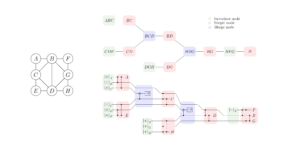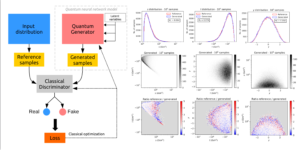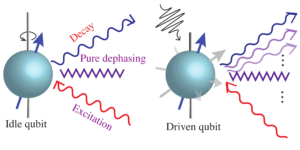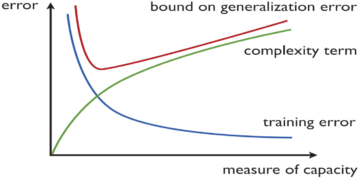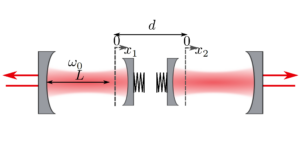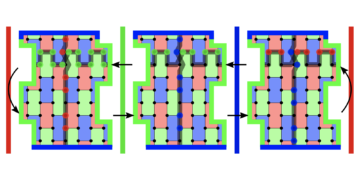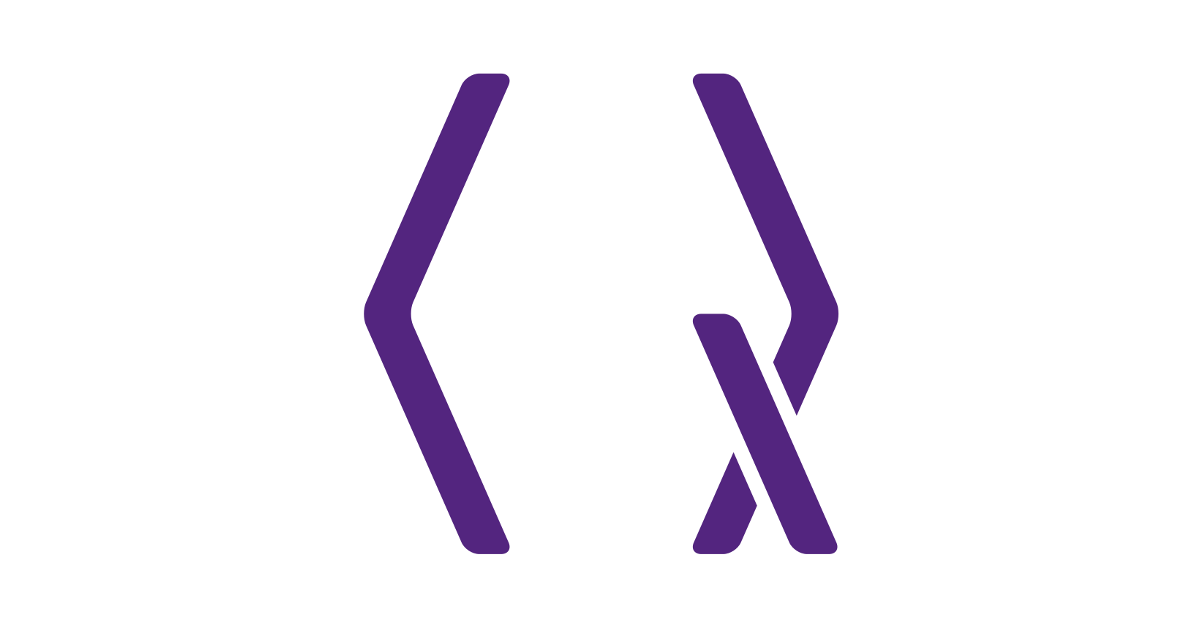
1Champalimaud Research, Champalimaud Center for the Unknown, 1400-038 Lisboa, Portugal
2Institute of Neuroscience, University of Oregon, Eugene, OR 97403, USA
3Department of Physics, University of Tehran, 14395-547, Tehran, Iran
4School of Particles and Accelerators, Institute for Research in Fundamental Sciences (IPM), P.O. Box 19395-5531 Tehran, Iran
5Complex Systems and Statistical Mechanics, Physics and Materials Science Research Unit, University of Luxembourg, L-1511 Luxembourg
Find this paper interesting or want to discuss? Scite or leave a comment on SciRate.
Abstract
We propose, formulate and examine novel quantum systems and behavioral phases in which momentary choices of the system’s memories interact in order to source the internal interactions and unitary time evolutions of the system. In a closed system of the kind, the unitary evolution operator is updated, moment by moment, by being remade out of the system’s `experience’, that is, its quantum state history. The `Quantum Memory Made’ Hamiltonians (QMM-Hs) which generate these unitary evolutions are Hermitian nonlocal-in-time operators composed of arbitrarily-chosen past-until-present density operators of the closed system or its arbitrary subsystems. The time evolutions of the kind are described by novel nonlocal nonlinear von Neumann and Schrödinger equations. We establish that nontrivial Purely-QMM unitary evolutions are `Robustly Non-Markovian’, meaning that the maximum temporal distances between the chosen quantum memories must exceed finite lower bounds which are set by the interaction couplings. After general formulation and considerations, we focus on the sufficiently-involved task of obtaining and classifying behavioral phases of one-qubit pure-state evolutions generated by first-to-third order polynomial QMM-Hs made out of one, two and three quantum memories. The behavioral attractors resulted from QMM-Hs are characterized and classified using QMM two-point-function observables as the natural probes, upon combining analytical methods with extensive numerical analyses. The QMM phase diagrams are shown to be outstandingly rich, having diverse classes of unprecedented unitary evolutions with physically remarkable behaviors. Moreover, we show that QMM interactions cause novel purely-internal dynamical phase transitions. Finally, we suggest independent fundamental and applied domains where the proposed `Experience Centric’ Unitary Evolutions can be applied natuarlly and advantageously.
Popular summary
In other words, the defining theme of the work is suggesting, formulating and investigating deep structural and behavioral interactions between Non-Markovianity, namely dependencies on the state history, and the fundamental principle of Unitarity. We present a general formulation of the aforementioned synergy which is followed by extensive analytical and numerical analyses of the structures and the consistent solutions of the resulted novel nonlocal-in-time nonlinear Schrödinger and von Neumann equations in general contexts and in the simplest models. As clearly manifested by these explorations, the behavioral effects of the proposed interactions between experience centricity and evolution unitarity are indeed enormous: the merge leads to a wide spectrum of unprecedented distinctive classes of quantum behaviors which are remarkable qualitatively.
Concluding the work as a first step towards the complete disclosure of the proposed ‘Experience-Centric Quantum Theory’, namely the theory of (emergent or fundamental) Experience-Centric Unitary Evolutions, we envision and indicate how it can be naturally applied in various independent domains such as (especially `Wheelerian’ frameworks of) quantum gravity, and quantum general intelligence.
► BibTeX data
► References
[1] Breuer, H. P., & Petruccione, F. The theory of open quantum systems. Oxford University Press (2002).
https://doi.org/10.1093/acprof:oso/9780199213900.001.0001
[2] Alicki, R., & Lendi, K. Quantum dynamical semigroups and applications (Vol. 717). Springer (2007).
https://doi.org/10.1007/3-540-18276-4
[3] Nielsen, M. A., & Chuang, I. L. Quantum Computation and Quantum Information: 10th Anniversary Edition. Cambridge University Press (2000).
[4] Bocchieri, P., & Loinger, A. “Quantum recurrence theorem”. Physical Review 107(2), 337 (1957).
https://doi.org/10.1103/PhysRev.107.337
[5] Kossakowski, A. “On quantum statistical mechanics of non-Hamiltonian systems”. Reports on Mathematical Physics, 3(4), 247-274 (1972).
https://doi.org/10.1016/0034-4877(72)90010-9
[6] Lindblad, G. “On the generators of quantum dynamical semigroups”. Communications in Mathematical Physics 48(2), 119-130 (1976).
https://doi.org/10.1007/BF01608499
[7] Gorini, V., Kossakowski, A., & Sudarshan, E. C. G. “Completely positive dynamical semigroups of N‐level systems”. Journal of Mathematical Physics 17(5), 821-825 (1976).
https://doi.org/10.1063/1.522979
[8] Bastidas, V. M., Kyaw, T. H., Tangpanitanon, J., Romero, G., Kwek, L. C., & Angelakis, D. G. “Floquet stroboscopic divisibility in non-Markovian dynamics”. New Journal of Physics 20(9), 093004 (2018).
https://doi.org/10.1088/1367-2630/aadcbd
[9] Zhang, W. M. “Exact master equation and general non-Markovian dynamics in open quantum systems”. The European Physical Journal Special Topics 227(15), 1849-1867 (2019).
https://doi.org/10.1140/epjst/e2018-800047-4
[10] Berk, G. D., Garner, A. J., Yadin, B., Modi, K., & Pollock, F. A. “Resource theories of multi-time processes: A window into quantum non-Markovianity”. Quantum 5, 435 (2021).
https://doi.org/10.22331/q-2021-04-20-435
[11] Rivas, Á., Huelga, S. F., & Plenio, M. B. “Quantum non-Markovianity: characterization, quantification and detection”. Reports on Progress in Physics 77(9), 094001 (2014).
https://doi.org/10.1088/0034-4885/77/9/094001
[12] Breuer, H. P., Laine, E. M., Piilo, J., & Vacchini, B. “Colloquium: Non-Markovian dynamics in open quantum systems”. Reviews of Modern Physics 88(2), 021002 (2016).
https://doi.org/10.1103/RevModPhys.88.021002
[13] De Vega, I., & Alonso, D. “Dynamics of non-Markovian open quantum systems”. Reviews of Modern Physics 89(1), 015001 (2017).
https://doi.org/10.1103/RevModPhys.89.015001
[14] Breuer, H. P., Laine, E. M., & Piilo, J. “Measure for the degree of non-Markovian behavior of quantum processes in open systems”. Physical Review Letters 103(21), 210401 (2009).
https://doi.org/10.1103/PhysRevLett.103.210401
[15] Laine, E. M., Piilo, J., & Breuer, H. P. “Measure for the non-Markovianity of quantum processes”. Physical Review A 81(6), 062115 (2010).
https://doi.org/10.1103/PhysRevA.81.062115
[16] Wißmann, S., Karlsson, A., Laine, E. M., Piilo, J., & Breuer, H. P. “Optimal state pairs for non-Markovian quantum dynamics”. Physical Review A 86(6), 062108 (2012).
https://doi.org/10.1103/PhysRevA.86.062108
[17] Rivas, Á., Huelga, S. F., & Plenio, M. B. “Entanglement and non-Markovianity of quantum evolutions”. Physical Review Letters 105(5), 050403 (2010).
https://doi.org/10.1103/PhysRevLett.105.050403
[18] Lorenzo, S., Plastina, F., & Paternostro, M. “Geometrical characterization of non-Markovianity”. Physical Review A 88(2), 020102 (2013).
https://doi.org/10.1103/PhysRevA.88.020102
[19] Chruściński, D., Kossakowski, A., & Rivas, Á. “Measures of non-Markovianity: Divisibility versus backflow of information”. Physical Review A 83(5), 052128 (2011).
https://doi.org/10.1103/PhysRevA.83.052128
[20] Chruściński, D., & Maniscalco, S. “Degree of non-Markovianity of quantum evolution”. Physical Review Letters 112(12), 120404 (2014).
https://doi.org/10.1103/PhysRevLett.112.120404
[21] Buscemi, F., & Datta, N. “Equivalence between divisibility and monotonic decrease of information in classical and quantum stochastic processes”. Physical Review A 93(1), 012101 (2016).
https://doi.org/10.1103/PhysRevA.93.012101
[22] Bylicka, B., Johansson, M., & Acin, A. “Constructive method for detecting the information backflow of bijective non-completely-positive-divisible dynamics”. Phys. Rev. Lett. 118(12), 120501 (2017).
https://doi.org/10.1103/PhysRevLett.118.120501
[23] Pollock, F. A., Rodríguez-Rosario, C., Frauenheim, T., Paternostro, M., & Modi, K. “Non-Markovian quantum processes: Complete framework and efficient characterization”. Physical Review A 97(1), 012127 (2018).
https://doi.org/10.1103/PhysRevA.97.012127
[24] Pollock, F. A., Rodríguez-Rosario, C., Frauenheim, T., Paternostro, M., & Modi, K. “Operational Markov condition for quantum processes”. Physical Review Letters 120(4), 040405 (2018).
https://doi.org/10.1103/PhysRevLett.120.040405
[25] Li, L., Hall, M. J., & Wiseman, H. M. “Concepts of quantum non-Markovianity: A hierarchy”. Physics Reports 759, 1-51 (2018).
https://doi.org/10.1016/j.physrep.2018.07.001
[26] Mazzola, L., Rodriguez-Rosario, C. A., Modi, K., & Paternostro, M. “Dynamical role of system-environment correlations in non-Markovian dynamics”. Physical Review A 86(1), 010102 (2012).
https://doi.org/10.1103/PhysRevA.86.010102
[27] Smirne, A., Mazzola, L., Paternostro, M., & Vacchini, B. “Interaction-induced correlations and non-Markovianity of quantum dynamics”. Physical Review A 87(5), 052129 (2013).
https://doi.org/10.1103/PhysRevA.87.052129
[28] Fanchini, F. F., Karpat, G., Çakmak, B., Castelano, L. K., Aguilar, G. H., Farías, O. J., … & De Oliveira, M. C. “Non-Markovianity through accessible information”. Physical Review Letters 112(21), 210402 (2014).
https://doi.org/10.1103/PhysRevLett.112.210402
[29] D’Arrigo, A., Franco, R. L., Benenti, G., Paladino, E., & Falci, G. “Recovering entanglement by local operations”. Annals of Physics 350, 211-224 (2014).
https://doi.org/10.1016/j.aop.2014.07.021
[30] Campbell, S., Ciccarello, F., Palma, G. M., & Vacchini, B. “System-environment correlations and Markovian embedding of quantum non-Markovian dynamics”. Physical Review A 98(1), 012142 (2018).
https://doi.org/10.1103/PhysRevA.98.012142
[31] Ciccarello, F., Palma, G. M., & Giovannetti, V. “Collision-model-based approach to non-Markovian quantum dynamics”. Physical Review A 87(4), 040103 (2013).
https://doi.org/10.1103/PhysRevA.87.040103
[32] Kretschmer, S., Luoma, K., & Strunz, W. T. “Collision model for non-Markovian quantum dynamics”. Physical Review A 94(1), 012106 (2016).
https://doi.org/10.1103/PhysRevA.94.012106
[33] Lorenzo, S., Ciccarello, F., Palma, G. M., & Vacchini, B. “Quantum non-Markovian piecewise dynamics from collision models”. Open Systems & Information Dynamics 24(04), 1740011 (2017).
https://doi.org/10.1142/S123016121740011X
[34] Rodríguez, F. J., Quiroga, L., Tejedor, C., Martin, M. D., Vina, L., & Andre, R. “Control of non-Markovian effects in the dynamics of polaritons in semiconductor microcavities”. Physical Review B 78(3), 035312 (2008).
https://doi.org/10.1103/PhysRevB.78.035312
[35] Gonzalez-Tudela, A., Rodriguez, F. J., Quiroga, L., & Tejedor, C. “Dissipative dynamics of a solid-state qubit coupled to surface plasmons: From non-Markov to Markov regimes”. Physical Review B 82(11), 115334 (2010).
https://doi.org/10.1103/PhysRevB.82.115334
[36] Man, Z. X., An, N. B., & Xia, Y. J. “Non-Markovian dynamics of a two-level system in the presence of hierarchical environments”. Optics express 23(5), 5763-5776 (2015).
https://doi.org/10.1364/oe.23.005763
[37] Man, Z. X., Xia, Y. J., & Franco, R. L. “Harnessing non-Markovian quantum memory by environmental coupling”. Physical Review A 92(1), 012315 (2015).
https://doi.org/10.1103/PhysRevA.92.012315
[38] Man, Z. X., Xia, Y. J., & Franco, R. L. “Cavity-based architecture to preserve quantum coherence and entanglement”. Scientific reports 5(1), 1-13 (2015).
https://doi.org/10.1038/srep13843
[39] Brito, F., & Werlang, T. “A knob for Markovianity”. New Journal of Physics 17(7), 072001 (2015).
https://doi.org/10.1088/1367-2630/17/7/072001
[40] Franco, R. L. “Switching quantum memory on and off”. New Journal of Physics 17(8), 081004 (2015).
https://doi.org/10.1088/1367-2630/17/8/081004
[41] Chiuri, A., Greganti, C., Mazzola, L., Paternostro, M., & Mataloni, P. “Linear optics simulation of quantum non-Markovian dynamics”. Scientific reports 2(1), 1-5 (2012).
https://doi.org/10.1038/srep00968
[42] Liu, B. H., Li, L., Huang, Y. F., Li, C. F., Guo, G. C., Laine, E. M., H. P. Breuer & Piilo, J. “Experimental control of the transition from Markovian to non-Markovian dynamics of open quantum systems”. Nature Physics 7(12), 931-934 (2011).
https://doi.org/10.1038/nphys2085
[43] Liu, B. H., Cao, D. Y., Huang, Y. F., Li, C. F., Guo, G. C., Laine, E. M., Breuer H. P., & Piilo, J. “Photonic realization of nonlocal memory effects and non-Markovian quantum probes”. Scientific reports 3(1), 1-6 (2013).
https://doi.org/10.1038/srep01781
[44] Bernardes, N. K., Cuevas, A., Orieux, A., Monken, C. H., Mataloni, P., Sciarrino, F., & Santos, M. F. “Experimental observation of weak non-Markovianity”. Scientific reports 5(1), 1-7 (2015).
https://doi.org/10.1038/srep17520
[45] Orieux, A., d’Arrigo, A., Ferranti, G., Franco, R. L., Benenti, G., Paladino, E., Falci G., Sciarrino F., & Mataloni, P. “Experimental on-demand recovery of entanglement by local operations within non-Markovian dynamics”. Scientific reports 5(1), 1-8 (2015).
https://doi.org/10.1038/srep08575
[46] Souza, A. M., Li, J., Soares-Pinto, D. O., Sarthour, R. S., Oliveira, S., Huelga, S. F., Paternostro M., & Semião, F. L. “Experimental demonstration of non-Markovian dynamics via a temporal bell-like inequality”. ArXiv preprint arXiv:1308.5761 (2013).
https://doi.org/10.48550/arXiv.1308.5761
arXiv:1308.5761
[47] Xu, J. S., Sun, K., Li, C. F., Xu, X. Y., Guo, G. C., Andersson, E., Franco R. L., & Compagno, G. “Experimental recovery of quantum correlations in absence of system-environment back-action”. Nature communications 4(1), 1-7 (2013).
https://doi.org/10.1038/ncomms3851
[48] Giorgi, G. L., Longhi, S., Cabot, A., & Zambrini, R. “Quantum Probing Topological Phase Transitions by Non‐Markovianity”. Annalen der Physik 531(12), 1900307 (2019).
https://doi.org/10.1002/andp.201900307
[49] Luo, D. W., You, J. Q., Lin, H. Q., Wu, L. A., & Yu, T. “Memory-induced geometric phase in non-Markovian open systems”. Physical Review A 98(5), 052117 (2018).
https://doi.org/10.1103/PhysRevA.98.052117
[50] Lorenzo, S., Ciccarello, F., & Palma, G. M. “Non-Markovian dynamics from band edge effects and static disorder”. International Journal of Quantum Information 15(08), 1740026 (2017).
https://doi.org/10.1142/S0219749917400263
[51] Dinc, F., Ercan, I., & Brańczyk, A. M. “Exact Markovian and non-Markovian time dynamics in waveguide QED: collective interactions, bound states in continuum, superradiance and subradiance”. Quantum 3, 213 (2019).
https://doi.org/10.22331/q-2019-12-09-213
[52] Wang, K. H., Chen, S. H., Lin, Y. C., & Li, C. M. “Non-Markovianity of photon dynamics in a birefringent crystal”. Physical Review A 98(4), 043850 (2018).
https://doi.org/10.1103/PhysRevA.98.043850
[53] Thanopulos, I., Karanikolas, V., Iliopoulos, N., & Paspalakis, E. “Non-Markovian spontaneous emission dynamics of a quantum emitter near a MoS 2 nanodisk”. Physical Review B 99(19), 195412 (2019).
https://doi.org/10.1103/PhysRevB.99.195412
[54] Sinha, K., Meystre, P., Goldschmidt, E. A., Fatemi, F. K., Rolston, S. L., & Solano, P. “Non-Markovian collective emission from macroscopically separated emitters”. Physical Review Letters 124(4), 043603 (2020).
https://doi.org/10.1103/PhysRevLett.124.043603
[55] Addis, C., Ciccarello, F., Cascio, M., Palma, G. M., & Maniscalco, S. “Dynamical decoupling efficiency versus quantum non-Markovianity”. New Journal of Physics 17(12), 123004 (2015).
https://doi.org/10.1088/1367-2630/17/12/123004
[56] Kutvonen, A., Ala-Nissila, T., & Pekola, J. “Entropy production in a non-Markovian environment”. Physical Review E 92(1), 012107 (2015).
https://doi.org/10.1103/PhysRevE.92.012107
[57] Goold, J., Paternostro, M., & Modi, K. “Nonequilibrium quantum Landauer principle”. Physical Review Letters 114(6), 060602 (2015).
https://doi.org/10.1103/PhysRevLett.114.060602
[58] Guarnieri, G., Uchiyama, C., & Vacchini, B. “Energy backflow and non-Markovian dynamics”. Physical Review A 93(1), 012118 (2016).
https://doi.org/10.1103/PhysRevA.93.012118
[59] Benatti, F., Ferialdi, L., & Marcantoni, S. Qubit entanglement generation by Gaussian non-Markovian dynamics. Journal of Physics A: Mathematical and Theoretical 52(3), 035305 (2018).
https://doi.org/10.1088/1751-8121/aaea13
[60] Aniello, P., Bae, J., & Chruscinski, D. “Quantum entropy and non-Markovian evolution”. ArXiv preprint arXiv:1809.06133 (2018).
https://doi.org/10.48550/arXiv.1809.06133
arXiv:1809.06133
[61] Naikoo, J., Dutta, S., & Banerjee, S. “Facets of quantum information under non-Markovian evolution”. Physical Review A 99(4), 042128 (2019).
https://doi.org/10.1103/PhysRevA.99.042128
[62] Arino, O., Hbid, M. L., & Dads, E. A. (Eds.) Delay Differential Equations and Applications: Proceedings of the NATO Advanced Study Institute held in Marrakech, Morocco, 9-21 September 2002 (Vol. 205). Springer Science & Business Media (2007).
https://doi.org/10.1007/1-4020-3647-7
[63] Roussel, M. R. Nonlinear Dynamics: A hands-on introductory survey. Morgan & Claypool Publishers (2019).
https://iopscience.iop.org/book/978-1-64327-464-5
[64] Erneux, T. Applied delay differential equations (Vol. 3), Springer Science & Business Media (2009).
https://doi.org/10.1007/978-0-387-74372-1
[65] Bani-Yaghoub, M. “Analysis and applications of delay differential equations in biology and medicine”. ArXiv preprint arXiv:1701.04173 (2017).
https://doi.org/10.48550/arXiv.1701.04173
arXiv:1701.04173
[66] Press, W. H., Teukolsky, S. A., Vetterling, W. T., & Flannery, B. P. Numerical Recipes with Source Code CD-ROM 3rd Edition: The Art of Scientific Computing. Cambridge University Press (2007).
https://www.cambridge.org/gb/academic/subjects/mathematics/numerical-recipes/numerical-recipes-art-scientific-computing-3rd-edition?format=HB
[67] Cotler, J., & Wilczek, F. “Entangled histories”. Physica Scripta 2016, 014004 (2016).
https://doi.org/10.1088/0031-8949/2016/T168/014004
[68] Nowakowski, M., Cohen, E., & Horodecki, P. “Entangled histories versus the two-state-vector formalism: Towards a better understanding of quantum temporal correlations”. Physical Review A 98(3), 032312 (2018).
https://doi.org/10.1103/PhysRevA.98.032312
[69] Mielnik, B. “Mobility of nonlinear systems”. Journal of Mathematical Physics 21(1), 44-54 (1980).
https://doi.org/10.1063/1.524331
[70] Mielnik, B. “Phenomenon of mobility in non-linear theories”. Communications in mathematical physics 101(3), 323-339 (1985).
https://doi.org/10.1007/BF01216093
[71] Czachor, M. Aspects of nonlinear quantum mechanics (Doctoral dissertation, Ph. D. thesis, Center for Theoretical Physics, Polish Academy of Sciences, Warszawa (1993)).
[72] Castellani, L. “History entanglement entropy”. Physica Scripta 96(5), 055217 (2021).
https://doi.org/10.1088/1402-4896/abe6c0
[73] Cuevas, Á., Geraldi, A., Liorni, C., Bonavena, L. D., De Pasquale, A., Sciarrino, F., Giovannetti, V., & Mataloni, P. “All-optical implementation of collision-based evolutions of open quantum systems”. Scientific reports 9(1), 1-8 (2019).
https://doi.org/10.1038/s41598-019-39832-9
[74] Bernardes, N. K., Cuevas, A., Orieux, A., Monken, C. H., Mataloni, P., Sciarrino, F., & Santos, M. F. “Experimental observation of weak non-Markovianity”. Scientific reports 5(1), 1-7 (2015).
https://doi.org/10.1038/srep17520
[75] Schmidt, R., Carusela, M. F., Pekola, J. P., Suomela, S., & Ankerhold, J. “Work and heat for two-level systems in dissipative environments: Strong driving and non-Markovian dynamics”. Physical Review B 91(22), 224303 (2015).
https://doi.org/10.1103/PhysRevB.91.224303
[76] Raja, S. H., Borrelli, M., Schmidt, R., Pekola, J. P., & Maniscalco, S. “Thermodynamic fingerprints of non-Markovianity in a system of coupled superconducting qubits”. Physical Review A 97(3), 032133 (2018).
https://doi.org/10.1103/PhysRevA.97.032133
[77] Wang, D., Huang, A. J., Hoehn, R. D., Ming, F., Sun, W. Y., Shi, J. D., Yu, L., & Kais, S. “Entropic uncertainty relations for Markovian and non-Markovian processes under a structured bosonic reservoir”. Scientific reports 7(1), 1-11 (2017).
https://doi.org/10.1038/s41598-017-01094-8
[78] Zhang, Y. J., Xia, Y. J., & Fan, H. “Control of quantum dynamics: Non-Markovianity and the speedup of the open system evolution”. EPL (Europhysics Letters) 116(3), 30001 (2016).
https://doi.org/10.1209/0295-5075/116/30001
[79] Ma, T., Chen, Y., Chen, T., Hedemann, S. R., & Yu, T. “Crossover between non-Markovian and Markovian dynamics induced by a hierarchical environment”. Physical Review A 90(4), 042108 (2014).
https://doi.org/10.1103/PhysRevA.90.042108
[80] Liu, B. H., Li, L., Huang, Y. F., Li, C. F., Guo, G. C., Laine, E. M., Breuer H.-P. & Piilo, J. “Experimental control of the transition from Markovian to non-Markovian dynamics of open quantum systems”. Nature Physics 7(12), 931-934 (2011).
https://doi.org/10.1038/nphys2085
[81] Fibich, G. The nonlinear Schrödinger equation. Berlin: Springer (2015).
https://doi.org/10.1007/978-3-319-12748-4
[82] Ablowitz, M. J., & Musslimani, Z. H. “Integrable nonlocal nonlinear Schrödinger equation”. Physical Review Letters 110(6), 064105 (2013).
https://doi.org/10.1103/PhysRevLett.110.064105
[83] Kevrekidis, P. G., Frantzeskakis, D. J., & Carretero-González, R. (Eds.) Emergent nonlinear phenomena in Bose-Einstein condensates: theory and experiment 45. Springer Science & Business Media (2007).
https://doi.org/10.1007/978-3-540-73591-5
[84] Kowalski, K., & Rembieliński, J. “Integrable nonlinear evolution of the qubit”. Annals of Physics, 411, 167955 (2019).
https://doi.org/10.1016/j.aop.2019.167955
[85] Al Khawaja, U., & Al Sakkaf, L. Handbook of exact solutions to the nonlinear Schrödinger equations. IOP publishing (2019).
https://doi.org/10.1088/978-0-7503-2428-1
[86] Essler, F. H., Frahm, H., Göhmann, F., Klümper, A., & Korepin, V. E. The one-dimensional Hubbard model. Cambridge University Press (2005).
https://doi.org/10.1017/CBO9780511534843
[87] Gasbarri, G., Belenchia, A., Carlesso, M. et al. “Testing the foundation of quantum physics in space via Interferometric and non-interferometric experiments with mesoscopic nanoparticles ”. Commun Phys 4, 155 (2021).
https://doi.org/10.1038/s42005-021-00656-7
[88] Gisin, N. “Gisin responds”. Physical Review Letters 53(18), 1776 (1984).
https://doi.org/10.1103/PhysRevLett.53.1776
[89] Gisin, N. “Stochastic quantum dynamics and relativity”. Helv. Phys. Acta 62(4), 363-371 (1989).
https://inis.iaea.org/search/searchsinglerecord.aspx?recordsFor=SingleRecord&RN=20077415
[90] Weinberg, S. “Precision tests of quantum mechanics”. Phys. Rev. Lett. 62, 485 (1989).
https://doi.org/10.1103/PhysRevLett.62.485
[91] Kibble, T. W. B. “Relativistic models of nonlinear quantum mechanics”. Communications in Mathematical Physics 64(1), 73-82 (1978).
https://doi.org/10.1007/BF01940762
[92] Ferrero, M., Salgado, D., & Sánchez-Gómez, J. L. “Nonlinear quantum evolution does not imply supraluminal communication”. Physical Review A, 70(1), 014101 (2004).
https://doi.org/10.1103/PhysRevA.70.014101
[93] Rembieliński, J., & Caban, P. “Nonlinear evolution and signaling”. Physical Review Research 2(1), 012027 (2020).
https://doi.org/10.1103/PhysRevResearch.2.012027
[94] Kaplan, D. E., & Rajendran, S. “Causal Framework for Nonlinear Quantum Mechanics”. Physical Review D 105, 055002 (2022).
https://doi.org/10.1103/PhysRevD.105.055002
[95] Polchinski, J. “Weinberg’s nonlinear quantum mechanics and the Einstein-Podolsky-Rosen paradox”. Physical Review Letters 66(4), 397 (1991).
https://doi.org/10.1103/PhysRevLett.66.397
[96] Jordan, T. F. “Reconstructing a nonlinear dynamical framework for testing quantum mechanics”. Annals of Physics 225(1), 83-113 (1993).
https://doi.org/10.1006/aphy.1993.1053
[97] Czachor, M., & Doebner, H. D. “Correlation experiments in nonlinear quantum mechanics”. Physics Letters A 301(3-4), 139-152 (2002).
https://doi.org/10.1016/S0375-9601(02)00959-3
[98] Kent, A. “Nonlinearity without superluminality”. Physical Review A 72(1), 012108 (2005).
https://doi.org/10.1103/PhysRevA.72.012108
[99] Helou, Bassam Mohamad. Testing Alternative Theories of Quantum Mechanics with Optomechanics, and Effective Modes for Gaussian Linear Optomechanics. Dissertation (Ph.D.), California Institute of Technology (2019).
https://doi.org/10.7907/KJ1K-9268
[100] Aerts, D., Czachor, M., & Durt, T. Probing the structure of quantum mechanics. Nonlinearity, nonlocality, computation, axiomatics, World Scientific Pub. Co (2002).
https://doi.org/10.1142/4885
[101] Parwani, R. R. “An information-theoretic link between spacetime symmetries and quantum linearity”. Annals of Physics 315(2), 419-452 (2005).
https://doi.org/10.1016/j.aop.2004.08.005
[102] ‘t Hooft, G. “Emergent Quantum Mechanics and Emergent Symmetries”. AIP Conf. Proc. 957 154 (2007).
https://doi.org/10.1063/1.2823751
[103] Adler, S. L. “Quantum Theory as an Emergent Phenomenon: Foundations and Phenomenology”. J. Phys.: Conf. Ser. 361 012002 (2012).
https://doi.org/10.1088/1742-6596/361/1/012002
[104] Caticha, A., Bartolomeo, D., & Reginatto, M. “Entropic dynamics: From entropy and information geometry to Hamiltonians and quantum mechanics”. AIP Conf. Proc. 1641 155 (2015).
https://doi.org/10.1063/1.4905974
[105] Minic, D. & Pajevic S. “Emergent “quantum” theory in complex adaptive systems”. Modern Physics Letters B 30 (11), 165020 (2016).
https://doi.org/10.1142/S0217984916502018
[106] Ipek, S., Abedi, M., & Caticha, A. “Entropic dynamics: reconstructing quantum field theory in curved space-time”. Class. Quantum Grav. 36 205013 (2019).
https://doi.org/10.1088/1361-6382/ab436c
[107] Vanchurin, V. “The world as a neural network”. Entropy 22(11), 1210 (2020).
https://doi.org/10.3390/e22111210
[108] Katsnelson, M.I., Vanchurin, V. “Emergent Quantumness in Neural Networks”. Found. Phys. 51, 94 (2021).
https://doi.org/10.1007/s10701-021-00503-3
[109] Horowitz, G. T., & Maldacena, J. “The black hole final state”. Journal of High Energy Physics 2004(02), 008 (2004).
https://doi.org/10.1088/1126-6708/2004/02/008
[110] Yurtsever, U., & Hockney, G. “Signalling, entanglement and quantum evolution beyond Cauchy horizons”. Classical and Quantum Gravity 22(2), 295 (2004).
https://doi.org/10.1088/0264-9381/22/2/004
[111] Lloyd, S., & Preskill, J. “Unitarity of black hole evaporation in final-state projection models”. Journal of High Energy Physics 2014(8), 1-30 (2014).
https://doi.org/10.1007/JHEP08(2014)126
[112] Wheeler, J. A. “Information, Physics, Quantum: The Search for links”. Proc. 3rd Int. Symp. Foundations of Quantum Mechanics, Tokyo, pp. 354-368, (1989).
https://doi.org/10.1201/9780429500459-19
[113] Svetlichny, G. “Nonlinear quantum mechanics at the Planck scale”. International Journal of Theoretical Physics 44(11), 2051-2058 (2005).
https://doi.org/10.1007/s10773-005-8983-1
[114] Banks, T., Fischler, W., Shenker, S. H., & Susskind, L. “$M$ theory as a matrix model: A conjecture”. Physical Review D 55(8), 5112 (1997).
https://doi.org/10.1103/PhysRevD.55.5112
[115] Konopka T., Markopoulou F., and Severini S. “Quantum graphity: A model of emergent locality”. Phys. Rev. D 77, 104029 (2008).
https://doi.org/10.1103/PhysRevD.77.104029
[116] Lee, S. S. “Emergent gravity from relatively local Hamiltonians and a possible resolution of the black hole information puzzle”. J. High Energ. Phys. 43 (2018).
https://doi.org/10.1007/JHEP10(2018)043
[117] Lee, S. S. “A model of quantum gravity with emergent spacetime”. J. High Energ. Phys. 70, 1-66 (2020).
https://doi.org/10.1007/JHEP06(2020)070
[118] Vanchurin, V. “Towards a theory of quantum gravity from neural networks”. Entropy 2022, 24(1), 7 (2021).
https://doi.org/10.3390/e24010007
[119] Alexander, S., Cunningham, W. J., Lanier, J., Smolin, L., Stanojevic, S., Toomey, M. W., & Wecker, D. “The Autodidactic Universe”. arXiv preprint arXiv:2104.03902 (2021).
https://doi.org/10.48550/arXiv.2104.03902
arXiv:2104.03902
[120] Kak, S. C. “Quantum neural computing”. Advances in imaging and electron physics 94, 259-313 (1995).
https://doi.org/10.1016/S1076-5670(08)70147-2
[121] Schuld, M., Sinayskiy, I., & Petruccione, F. “The quest for a quantum neural network”. Quantum Information Processing 13(11), 2567-2586 (2014).
https://doi.org/10.1007/s11128-014-0809-8
[122] Biamonte, J., Wittek, P., Pancotti, N., Rebentrost, P., Wiebe, N., & Lloyd, S. “Quantum machine learning”. Nature 549(7671), 195-202 (2017).
https://doi.org/10.1038/nature23474
[123] Dunjko, V., & Briegel, H. J. “Machine learning & artificial intelligence in the quantum domain: a review of recent progress”. Reports on Progress in Physics 81(7), 074001 (2018).
https://doi.org/10.1088/1361-6633/aab406
[124] Wittek, P. (2014). Quantum machine learning: what quantum computing means to data mining. Academic Press (2014).
https://www.elsevier.com/books/quantum-machine-learning/wittek/978-0-12-800953-6
[125] Kristensen, L. B., Degroote, M., Wittek, P., Aspuru-Guzik, A., & Zinner, N. T. “An artificial spiking quantum neuron”. npj Quantum Information 7(1), 1-7 (2021).
https://doi.org/10.1038/s41534-021-00381-7
[126] Ciliberto, C., Herbster, M., Ialongo, A. D., Pontil, M., Rocchetto, A., Severini, S., & Wossnig, L. “Quantum machine learning: a classical perspective”. Proceedings of the Royal Society A: Mathematical, Physical and Engineering Sciences 474(2209), 20170551 (2018).
https://doi.org/10.1098/rspa.2017.0551
[127] Arunachalam, S., & de Wolf, R. “Guest column: A survey of quantum learning theory”. ACM SIGACT News 48(2), 41-67 (2017).
https://doi.org/10.1145/3106700.3106710
[128] Gonzalez-Raya, T., Solano, E., & Sanz, M. “Quantized three-ion-channel neuron model for neural action potentials”. Quantum 4, 224 (2020).
https://doi.org/10.22331/q-2020-01-20-224
[129] Garg, S., & Ramakrishnan, G. “Advances in quantum deep learning: An overview”. ArXiv preprint arXiv:2005.04316 (2020).
https://doi.org/10.48550/arXiv.2005.04316
arXiv:2005.04316
[130] Abbas, A., Sutter, D., Zoufal, C., Lucchi, A., Figalli, A., & Woerner, S. “The power of quantum neural networks”. Nature Computational Science 1(6), 403-409 (2021).
https://doi.org/10.1038/s43588-021-00084-1
[131] Carleo, G., Cirac, I., Cranmer, K., Daudet, L., Schuld, M., Tishby, N., … & Zdeborová, L. “Machine learning and the physical sciences”. Reviews of Modern Physics 91(4), 045002 (2019).
https://doi.org/10.1103/RevModPhys.91.045002
[132] Cornelissen, A. Quantum gradient estimation and its application to quantum reinforcement learning, Master thesis, TU Delft (2018).
http://resolver.tudelft.nl/uuid:26fe945f-f02e-4ef7-bdcb-0a2369eb867e
[133] Saggio, V., Asenbeck, B. E., Hamann, A., Strömberg, T., Schiansky, P., Dunjko, V., … & Walther, P. “Experimental quantum speed-up in reinforcement learning agents”. Nature 591(7849), 229-233 (2021).
https://doi.org/10.1038/s41586-021-03242-7
[134] Dong, D., Chen, C., Li, H., & Tarn, T. J. “Quantum reinforcement learning”. IEEE Transactions on Systems, Man, and Cybernetics, Part B (Cybernetics) 38(5), 1207-1220 (2008).
https://doi.org/10.1109/TSMCB.2008.925743
[135] Barry, J., Barry, D. T., & Aaronson, S. “Quantum partially observable Markov decision processes”. Physical Review A 90(3), 032311 (2014).
https://doi.org/10.1103/PhysRevA.90.032311
[136] Bagarello, F., Haven, E., & Khrennikov, A. “A model of adaptive decision-making from representation of information environment by quantum fields”. Philosophical Transactions of the Royal Society A: Mathematical, Physical and Engineering Sciences 375(2106), 20170162 (2017).
https://doi.org/10.1098/rsta.2017.0162
[137] Yukalov, V. I. “Evolutionary processes in quantum decision theory”. Entropy 22(6), 681 (2020).
https://doi.org/10.3390/e22060681
[138] Ashtiani, M., & Azgomi, M. A. “A survey of quantum-like approaches to decision making and cognition”. Mathematical Social Sciences 75, 49-80 (2015).
https://doi.org/10.1016/j.mathsocsci.2015.02.004
[139] Busemeyer, J., & Bruza, P. Quantum Models of Cognition and Decision, Cambridge University Press (2012).
https://doi.org/10.1017/CBO9780511997716
[140] Favre, M., Wittwer, A., Heinimann, H. R., Yukalov, V. I., & Sornette, D. “Quantum decision theory in simple risky choices”. PloS one 11(12), e0168045 (2016).
https://doi.org/10.1371/journal.pone.0168045
[141] Martínez-Martínez, I., & Sánchez-Burillo, E. “Quantum stochastic walks on networks for decision-making”. Scientific Reports, 6(1), 1-13 (2016).
https://doi.org/10.1038/srep23812
[142] Khrennikov A. “Quantum Bayesianism as the basis of general theory of decision-making”. Philosophical Transactions of the Royal Society A: Mathematical, Physical and Engineering Sciences 374, no. 2068, p. 20 150 245 (2016).
https://doi.org/10.1098/rsta.2015.0245
[143] Busemeyer, J., Zhang, Q., Balakrishnan, S. N., & Wang, Z. “Application of quantum—Markov open system models to human cognition and decision”. Entropy 22(9), 990 (2020).
https://doi.org/10.3390/e22090990
[144] Li, J. A., Dong, D., Wei, Z., Liu, Y., Pan, Y., Nori, F., & Zhang, X. “Quantum reinforcement learning during human decision-making”. Nature Human Behaviour 4(3), 294-307 (2020).
https://doi.org/10.1038/s41562-019-0804-2
[145] de Oliveira, M., & Barbosa, L. S. “Quantum Bayesian decision-making”. Foundations of Science 28, 21-41 (2023).
https://doi.org/10.1007/s10699-021-09781-6
[146] DeBrota J. B. & Love P. J. “Quantum and Classical Bayesian Agents”. Quantum 6, 713 (2022).
https://doi.org/10.22331/q-2022-05-16-713
[147] Andrecut M., Ali M. “Quantum Associative Memory”. International Journal of Modern Physics B 17(12), 2447 (2003).
https://doi.org/10.1142/S0217979203018284
[148] Trugenberger C. A. “Probabilistic Quantum Memories”. Physical Review Letters 87, 067901 (2001).
https://doi.org/10.1103/PhysRevLett.87.067901
[149] Santra, S., Shehab, O., & Balu, R. “Ising formulation of associative memory models and quantum annealing recall”. Physical Review A 96(6), 062330 (2017).
https://doi.org/10.1103/PhysRevA.96.062330
[150] Monras A., Beige A., and Wiesner K. “Hidden Quantum Markov Models and non-adaptive read-out of many-body states”. Appl. Math. and Comp. Sciences 3, 93 (2011).
https://doi.org/10.48550/arXiv.1002.2337
[151] Clark, L. A., Huang, W., Barlow, T. M., and Beige, A. “Hidden quantum markov models and open quantum systems with instantaneous feedback”. ISCS 2014: Interdisciplinary Symposium on Complex Systems, pages 143–151, Springer (2015).
https://doi.org/10.48550/arXiv.1406.5847
[152] Ho M., Gu M., and Elliott T. J. “Robust inference of memory structure for efficient quantum modeling of stochastic processes”. Phys. Rev. A 101, 032327 (2020).
https://doi.org/10.1103/PhysRevA.101.032327
[153] Abrams, D. S., & Lloyd, S. “Nonlinear quantum mechanics implies polynomial-time solution for NP-complete and# P problems”. Physical Review Letters 81(18), 3992 (1998).
https://doi.org/10.1103/PhysRevLett.81.3992
[154] Czachor, M. “Local modification of the Abrams-Lloyd nonlinear algorithm”. ArXiv preprint quant-ph/9803019 (1998).
https://doi.org/10.48550/arXiv.quant-ph/9803019
arXiv:quant-ph/9803019
[155] Aaronson, S. Guest column: “NP-complete problems and physical reality”. ACM Sigact News 36(1), 30-52 (2005).
https://doi.org/10.1145/1052796.1052804
[156] Panella, M., & Martinelli, G. “Neurofuzzy networks with nonlinear quantum learning”. IEEE Transactions on Fuzzy Systems 17(3), 698-710 (2008).
https://doi.org/10.1109/TFUZZ.2008.928603
[157] Panella, M., & Martinelli, G. “Neural networks with quantum architecture and quantum learning”. International Journal of Circuit Theory and Applications 39(1), 61-77 (2011).
https://doi.org/10.1002/cta.619
[158] Meyer, D. A., & Wong, T. G. “Nonlinear quantum search using the Gross–Pitaevskii equation”. New Journal of Physics 15(6), 063014 (2013).
https://doi.org/10.1088/1367-2630/15/6/063014
[159] Meyer, D. A., & Wong, T. G. “Quantum search with general nonlinearities”. Physical Review A 89(1), 012312 (2014).
https://doi.org/10.1103/PhysRevA.89.012312
[160] da Silva, A. J., Ludermir, T. B., & de Oliveira, W. R. “Quantum perceptron over a field and neural network architecture selection in a quantum computer”. Neural Networks 76, 55-64 (2016).
https://doi.org/10.1016/j.neunet.2016.01.002
[161] Childs, A. M., & Young, J. “Optimal state discrimination and unstructured search in nonlinear quantum mechanics”. Physical Review A 93(2), 022314 (2016).
https://doi.org/10.1103/PhysRevA.93.022314
[162] Geller, M. R. “Fast quantum state discrimination with nonlinear PTP channels”. ArXiv preprint arXiv:2111.05977 (2021).
https://doi.org/10.48550/arXiv.2111.05977
arXiv:2111.05977
[163] Tacchino, F., Macchiavello, C., Gerace, D., Bajoni D. “An artificial neuron implemented on an actual quantum processor”. npj Quantum Information 5, 26 (2019).
https://doi.org/10.1038/s41534-019-0140-4
[164] de Paula Neto, F. M., Ludermir, T. B., de Oliveira, W. R., & da Silva, A. J. “Implementing any nonlinear quantum neuron”. IEEE transactions on neural networks and learning systems 31(9), 3741-3746 (2019).
https://doi.org/10.1109/TNNLS.2019.2938899
[165] Yan, S., Qi, H., & Cui, W. “Nonlinear quantum neuron: A fundamental building block for quantum neural networks”. Physical Review A 102(5), 052421 (2020).
https://doi.org/10.1103/PhysRevA.102.052421
[166] Chen, S., Cotler, J., Huang, H. Y., & Li, J. “Exponential separations between learning with and without quantum memory”. ArXiv preprint arXiv:2111.05881 (2021).
https://doi.org/10.48550/arXiv.2111.05881
arXiv:2111.05881
[167] Sompolinsky H. and Kanter I. “Temporal Association in Asymmetric Neural Networks”. Phys. Rev. Lett. 57, 2861 (1986).
https://doi.org/10.1103/PhysRevLett.57.2861
[168] Hertz, J., Krogh, A., & Palmer, R.G. Introduction to the Theory of Neural Computation (1st ed.) (Santa Fe Institute Series) CRC Press (1991).
https://doi.org/10.1201/9780429499661
[169] Baldi P. and Atiya A. F. “How delays affect neural dynamics and learning”. IEEE Transactions on Neural Networks 5(4), 612-621 (1994).
https://doi.org/10.1109/72.298231
[170] Recanatesi, S., Pereira-Obilinovic, U., Murakami, M., Mainen, Z., & Mazzucato, L. “Metastable attractors explain the variable timing of stable behavioral action sequences”. Neuron 110, Issue 1, 5 January 2022, Pages 139-153.e9 (2021).
https://doi.org/10.1016/j.neuron.2021.10.011
[171] Spalla, D., Cornacchia, I. M., & Treves, A. “Continuous attractors for dynamic memories”. eLife 10, e69499 (2021).
https://doi.org/10.7554/elife.69499
[172] Parmelee, C., Alvarez, J. L., Curto, C., & Morrison, K. “Sequential attractors in combinatorial threshold-linear networks”. ArXiv preprint arXiv:2107.10244 (2021).
https://doi.org/10.48550/arXiv.2107.10244
arXiv:2107.10244
[173] Rebentrost, P., Bromley, T. R., Weedbrook, C., & Lloyd, S. “Quantum Hopfield neural network”. Physical Review A 98(4), 042308 (2018).
https://doi.org/10.1103/PhysRevA.98.042308
[174] Shcherbina, M., Tirozzi, B., & Tassi, C. “Quantum Hopfield Model”. Physics 2(2), 184-196 (2020).
https://doi.org/10.3390/physics2020012
[175] Schuld, M. “Quantum machine learning for supervised pattern recognition”. Doctoral dissertation, University of KwaZulu-Natal Durban, South Africa (2017).
http://hdl.handle.net/10413/15748
[176] Rotondo, P., Marcuzzi, M., Garrahan, J. P., Lesanovsky, I., & Müller, M. “Open quantum generalisation of Hopfield neural networks”. Journal of Physics A: Mathematical and Theoretical 51(11), 115301 (2018).
https://doi.org/10.1088/1751-8121/aaabcb
[177] Amin, M. H., Andriyash, E., Rolfe, J., Kulchytskyy, B., & Melko, R. “Quantum Boltzmann machine.” Physical Review X 8(2), 021050 (2018).
https://doi.org/10.1103/PhysRevX.8.021050
[178] Zoufal, C., Lucchi, A. & Woerner, S. “Variational quantum Boltzmann machines”. Quantum Mach. Intell. 3, 7 (2021).
https://doi.org/10.1007/s42484-020-00033-7
[179] Fard, E. R., Aghayar, K., & Amniat-Talab, M. “Quantum pattern recognition with multi-neuron interactions”. Quantum Information Processing 17(3), 1-17 (2018).
https://doi.org/10.1007/s11128-018-1816-y
[180] Ramsauer, H., Schäfl, B., Lehner, J., Seidl, P., Widrich, M., Adler, T., … & Hochreiter, S. “Hopfield networks is all you need”. ArXiv preprint arXiv:2008.0221 (2020).
https://doi.org/10.48550/arXiv.2008.02217
arXiv:2008.0221
[181] Krotov, D., & Hopfield, J. “Large associative memory problem in neurobiology and machine learning”. ArXiv preprint arXiv:2008.06996 (2020).
https://doi.org/10.48550/arXiv.2008.06996
arXiv:2008.06996
[182] Cong, I., Choi, S. & Lukin, M.D. “Quantum convolutional neural networks”. Nat. Phys. 15, 1273–1278 (2019).
https://doi.org/10.1038/s41567-019-0648-8
[183] Briegel, H., De las Cuevas, G. “Projective simulation for artificial intelligence”. Sci Rep 2, 400 (2012).
https://doi.org/10.1038/srep00400
[184] Melnikov, A.A., Makmal, A., Dunjko, V., Briegel H. J. “Projective simulation with generalization”. Sci Rep 7, 14430 (2017).
https://doi.org/10.1038/s41598-017-14740-y
Cited by
Could not fetch Crossref cited-by data during last attempt 2023-05-15 13:23:06: Could not fetch cited-by data for 10.22331/q-2023-05-15-1007 from Crossref. This is normal if the DOI was registered recently. On SAO/NASA ADS no data on citing works was found (last attempt 2023-05-15 13:23:06).
This Paper is published in Quantum under the Creative Commons Attribution 4.0 International (CC BY 4.0) license. Copyright remains with the original copyright holders such as the authors or their institutions.
- SEO Powered Content & PR Distribution. Get Amplified Today.
- PlatoAiStream. Web3 Data Intelligence. Knowledge Amplified. Access Here.
- Minting the Future w Adryenn Ashley. Access Here.
- Buy and Sell Shares in PRE-IPO Companies with PREIPO®. Access Here.
- Source: https://quantum-journal.org/papers/q-2023-05-15-1007/
- :has
- :is
- :not
- :where
- ][p
- $UP
- 1
- 10
- 100
- 10th
- 11
- 116
- 12
- 13
- 14
- 15%
- 1984
- 1985
- 1994
- 1998
- 1st
- 20
- 2001
- 2011
- 2012
- 2013
- 2014
- 2015
- 2016
- 2017
- 2018
- 2019
- 2020
- 2021
- 2022
- 2023
- 22
- 23
- 24
- 26%
- 27
- 28
- 30
- 39
- 3rd
- 40
- 49
- 50
- 66
- 67
- 7
- 70
- 72
- 77
- 8
- 84
- 87
- 9
- 91
- 98
- a
- Abbas
- ABSTRACT
- academic
- Academy
- accelerators
- access
- accessible
- accordingly
- ACM
- Action
- actual
- advanced
- advances
- affect
- affiliations
- africa
- After
- agents
- aip
- AL
- Alexander
- algorithm
- All
- alternative
- alvarez
- an
- Analyses
- Analytical
- and
- Anniversary
- any
- Application
- applications
- applied
- approach
- approaches
- architecture
- Archive
- ARE
- Art
- artificial
- artificial intelligence
- AS
- aspects
- Association
- At
- author
- authors
- BAND
- Banks
- basis
- Bayesian
- BE
- being
- Berlin
- Better
- between
- Beyond
- biology
- Black
- Black Hole
- Block
- Bound
- Box
- Break
- Building
- business
- by
- california
- cambridge
- CAN
- Cause
- Center
- central
- channels
- characterized
- chen
- choices
- chosen
- class
- classes
- classified
- clearly
- closed
- CO
- code
- Collective
- Column
- combining
- comment
- Commons
- Communication
- Communications
- COMP
- complete
- complex
- composed
- computation
- computer
- computing
- condition
- conjecture
- considerations
- consistent
- Consisting
- contains
- contexts
- Continuum
- control
- copyright
- could
- coupled
- CRC
- Crystal
- Curto
- da
- data
- data mining
- decision
- Decision Making
- decrease
- deep
- deep learning
- defining
- Degree
- delay
- delays
- described
- Detection
- developed
- diagrams
- directing
- disclosure
- discuss
- diverse
- does
- domain
- domains
- driving
- during
- dynamic
- dynamics
- e
- E&T
- ed
- Edge
- edition
- Effective
- effects
- efficiency
- efficient
- Elliott
- embedding
- emission
- energy
- Engineering
- enormous
- Environment
- environmental
- environments
- envision
- equations
- especially
- establish
- European
- evolution
- evolutions
- examine
- exceed
- experience
- experiment
- experiments
- Explain
- express
- extensive
- fan
- feedback
- field
- Fields
- final
- Finally
- First
- Focus
- followed
- For
- formed
- formulating
- found
- Foundation
- Foundations
- Framework
- frameworks
- from
- fundamental
- General
- general intelligence
- generate
- generated
- generation
- generators
- gravity
- Guest
- Hall
- handle
- hands-on
- harvard
- having
- Held
- hertz
- hierarchy
- High
- history
- holders
- Hole
- Horizons
- Horowitz
- How
- http
- HTTPS
- human
- i
- idea
- IEEE
- if
- Imaging
- implementation
- implemented
- in
- Inclusive
- independent
- indicate
- information
- initial
- Institute
- institutions
- Intelligence
- interact
- interacting
- interaction
- interactions
- interesting
- internal
- International
- into
- Introduction
- introductory
- issue
- IT
- ITS
- itself
- January
- JavaScript
- Jordan
- journal
- Key
- Kind
- LAS
- Last
- Leads
- learning
- Leave
- Lee
- Li
- License
- LINK
- links
- local
- love
- lower
- Luxembourg
- machine
- machine learning
- Machines
- made
- Making
- man
- Marco
- Martin
- master
- materials
- math
- mathematical
- Matrix
- maximum
- May..
- meaning
- means
- mechanics
- Media
- medicine
- Memories
- Memory
- Merge
- method
- methods
- Meyer
- Mining
- mobility
- model
- models
- Modern
- modes
- moment
- Month
- Moreover
- Morgan
- Morocco
- must
- namely
- Natural
- Nature
- Near
- Need
- network
- networks
- neural network
- neural networks
- Neuroscience
- New
- news
- no
- normal
- novel
- now
- obtaining
- of
- off
- on
- On-Demand
- ONE
- open
- Operations
- operator
- operators
- optics
- or
- order
- Oregon
- original
- Other
- out
- over
- overview
- Oxford
- oxford university
- pairs
- Paper
- Paradox
- part
- Pattern
- perspective
- phase
- phenomenon
- physical
- Physical Sciences
- Physically
- Physics
- plato
- Plato Data Intelligence
- PlatoData
- plays
- Polish
- positive
- possibility
- possible
- power
- presence
- present
- press
- principle
- Problem
- problems
- PROC
- Proceedings
- processes
- processing
- Processor
- Production
- Progress
- Projection
- propose
- proposed
- published
- publisher
- publishers
- Publishing
- puzzle
- Qi
- Quantum
- Quantum Annealing
- Quantum Computer
- quantum computing
- quantum information
- quantum machine learning
- Quantum Mechanics
- quantum physics
- quantum systems
- Qubit
- qubits
- quest
- Reality
- realization
- recent
- recently
- recognition
- Recover
- recovery
- recurrence
- references
- regimes
- registered
- relations
- relatively
- relativity
- remains
- remarkable
- Reports
- representation
- research
- Resolution
- review
- Reviews
- Rich
- Risky
- Role
- royal
- s
- Santa
- Scale
- SCI
- Science
- SCIENCES
- scientific
- Search
- selection
- semiconductor
- September
- Series
- set
- show
- shown
- silva
- Simple
- simulation
- Social
- Society
- solution
- Solutions
- Source
- source code
- sourced
- Sourcing
- South
- South Africa
- Space
- special
- Spectrum
- stable
- State
- States
- statistical
- Step
- strong
- structural
- structure
- structured
- Study
- such
- suggest
- Sun
- superconducting
- Surface
- Survey
- Symposium
- synergy
- system
- Systems
- Task
- Technology
- tehran
- Testing
- tests
- that
- The
- the information
- The Merge
- The State
- their
- theme
- themselves
- theoretical
- theory
- These
- thesis
- this
- those
- three
- Through
- time
- timing
- Title
- to
- together
- tokyo
- toomey
- Topics
- towards
- Transactions
- transition
- transitions
- two
- Uncertainty
- under
- understanding
- unit
- Universe
- university
- unknown
- unprecedented
- until
- updated
- updating
- upon
- URL
- using
- various
- Versus
- via
- volume
- von
- W
- want
- was
- we
- What
- which
- wide
- with
- within
- without
- Wolf
- words
- Work
- works
- world
- wu
- X
- year
- You
- young
- zephyrnet


